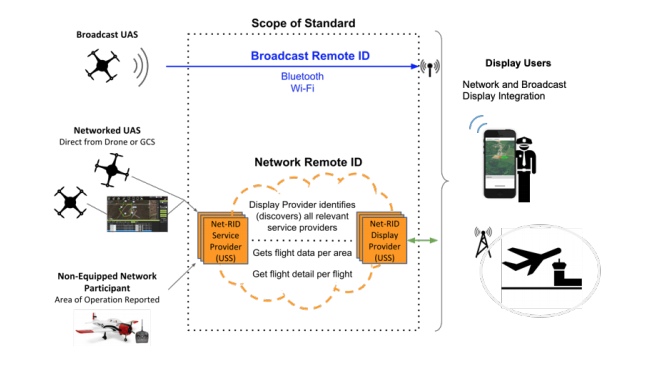The Drone Advisory Committee (DAC), in its meeting with Federal Aviation Administration on 17 October, has developed a series of recommendations for voluntary equipage of remote identification technologies by UAS manufacturers or operators and what types of incentives, if any, could be provided by the FAA for operators who voluntarily use UAS equipped with Remote ID.
The following text is an excerpt from the minutes of the meeting.
What voluntary equipage of remote identification technologies by UAS manufacturers or operators could occur in the short-term prior to a Final Rule for remote identification?
The entire Task 1 group unanimously agreed to recommend the ASTM Remote ID (RID) standard to the DAC as the equipage basis for the voluntary program. The RID standard has a scope that includes various means to perform Remote ID. The standard is intended to be a world-wide adaptable standard. Therefore, it is expected that a regulator would add a regulatory “overlay” and Minimal Operational Performance Standard (MOPS) on top of the ASTM standard as part of regulatory implementation. As with other ASTM references by the FAA, this overlay may specify requirements for certain fields and may override other standard requirements. To participate in the voluntary Remote ID Program, the UAS must perform Remote ID according to the ASTM Standard using any one of the following methods outlined in the standard:
o Broadcast: Bluetooth 4 or 5
o Broadcast: Wi-Fi
o Network
- Through a connected UAS, or,
- Non-Equipped Network Participant
The method used must function in the area of operation. Participants must support all required fields in the ASTM standard. Optional fields may be used at participant’s discretion.
In the absence of Remote ID of UAS and in consideration of security partners’ concerns regarding operations over people and other waivered operations under Part 107 in the intervening period, the FAA tasked the DAC to develop recommendations on: What types of incentives, if any, could be provided by the FAA for operators who voluntarily use UAS equipped with Remote ID?
The Incentives Subgroup came up with the following recommendations:
Voluntary Remote ID Equipage Incentives Recommendations
Ease of compliance
- The cost and ease of compliance should be kept at a reasonable level such that commercial and recreational operators see that the benefits outweigh the cost of adopting Remote ID
- Incentives provided by FAA
- The FAA and other government agencies procuring contracts for UAS services or systems should give preferential treatment to operators or systems that have Remote ID Waiver Application Preference
- The FAA should prioritize Part 107 waiver applications from operators who have Remote ID and provide accelerated processing of their applications Satisfy a Component of Waiver, Exemption, or Application Requirement
- Remote ID should help mitigate the security concerns surrounding anonymous flying for operations over people or beyond visual line of sight waivers
- Night operations should be facilitated through a blanket waiver when the operator has Remote ID and operates consistent with the “Operation of Small Unmanned Aircraft Systems Over People” proposed rule requirements that relate to night operations Acknowledgement of Equipage To raise awareness and acceptance of Remote ID for consumers, manufacturers and service providers, the FAA should:
- Create an online database of manufacturers who have self-declared Remote ID equipped drones
- Create an online database of self-certified network Remote ID service providers Airspace Access 12
- The FAA should partner with security agencies to allow Remote ID equipped UAS operations that are otherwise compliant with FAA rules and regulations in the outer ring (between the 10 and 30 NM ring) of a 14 CFR 91.141 VIP Temporary Flight Restriction (TFR)
- In cooperation with other security agencies, the FAA should grant access to allow Remote ID equipped UAS operations in other airspace areas that are restricted due to security concerns
- FAA should promote voluntary Remote ID equipage via future rulemaking efforts, such as Section 2209, that promote improved airspace access
- In many locations, the LAANC grid squares indicate a 0-foot allowable altitude for automatic LAANC approvals. The FAA should evaluate raising the allowable altitude for automatic LAANC approvals from 0 ft up to 100 ft in those locations for Remote ID equipped UAS operations if such an increase does not create a material decrease in safety for manned aircraft operations FAA Rebate
- The FAA should provide a financial rebate in collaboration with Remote ID drone manufacturers or software suppliers to offset the cost for compliance, similar to the FAA ADS-B rebate Monetary Incentive
- Operators who have taken the Part 107 knowledge exam should be eligible for some amount of reimbursement provided they utilize a UAS with Remote ID
- The FAA should provide a discount on FAA UAS Symposium or other FAA events with associated costs
- The FAA should waive future drone registration fees for additional UAS or renewals after the initial application
The DAC was developed to serve as a broad-based, long-term advisory entity that provides the FAA with advice on key Unmanned Aircraft Systems (UAS) integration issues by helping to identify challenges and prioritize improvements. The committee helps to create broad support for an overall integration strategy and vision. Membership is comprised of CEO/COO-level executives from a cross-section of stakeholders representing the wide variety of UAS interests, including industry, research and academia, local government and first responders, retail, and technology.
For more information




